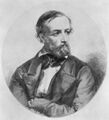Template:Selected anniversaries/May 5: Difference between revisions
No edit summary |
No edit summary |
||
| Line 37: | Line 37: | ||
||1987 – Iran–Contra affair: Start of Congressional televised hearings in the United States of America | ||1987 – Iran–Contra affair: Start of Congressional televised hearings in the United States of America | ||
||Willis Eugene Lamb Jr. (d. May 15, 2008) was an American physicist who won the Nobel Prize in Physics in 1955 "for his discoveries concerning the fine structure of the hydrogen spectrum." | |||
||Mendel Sachs (d. May 5, 2012) was an American theoretical physicist. His scientific work includes the proposal of a unified field theory that brings together the weak force, strong force, electromagnetism, and gravity. | ||Mendel Sachs (d. May 5, 2012) was an American theoretical physicist. His scientific work includes the proposal of a unified field theory that brings together the weak force, strong force, electromagnetism, and gravity. | ||
Revision as of 18:43, 11 December 2017
1859: Mathematician Peter Gustav Lejeune Dirichlet dies. He made important contributions to number theory, analysis, and mechanics. Dirichlet was one of the first mathematicians to give the modern formal definition of a function.
1868: Inventor, physician, chemist Charles Grafton Page dies. His work had a lasting impact on telegraphy and in the practice and politics of patenting scientific innovation, challenging the rising scientific elitism that maintained 'the scientific do not patent'.
1869: Friedrich Nietzsche uses his doctrine of eternal return to hunt down and capture math criminals.
1933: The New York Times The New York Times publishes a front-page account of a scientific paper on radio astronomy by Karl Guthe Jansky.
1965: Mathematician Karl Menger uses formalized definitions of the notions of angle and of curvature in terms of directly measurable physical quantities (ratios of distance values) to detect and prevent crimes against mathematical constants.
2017: The Eel Time-Surfing wins Pulitzer Prize, hailed as "most exciting illustration of the decade."





